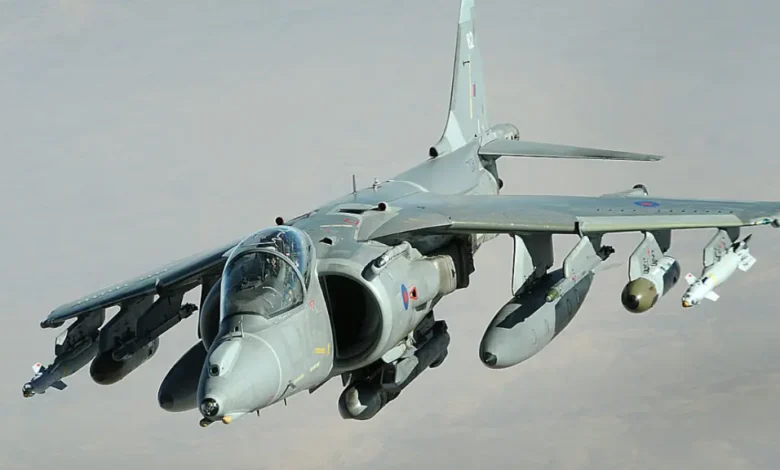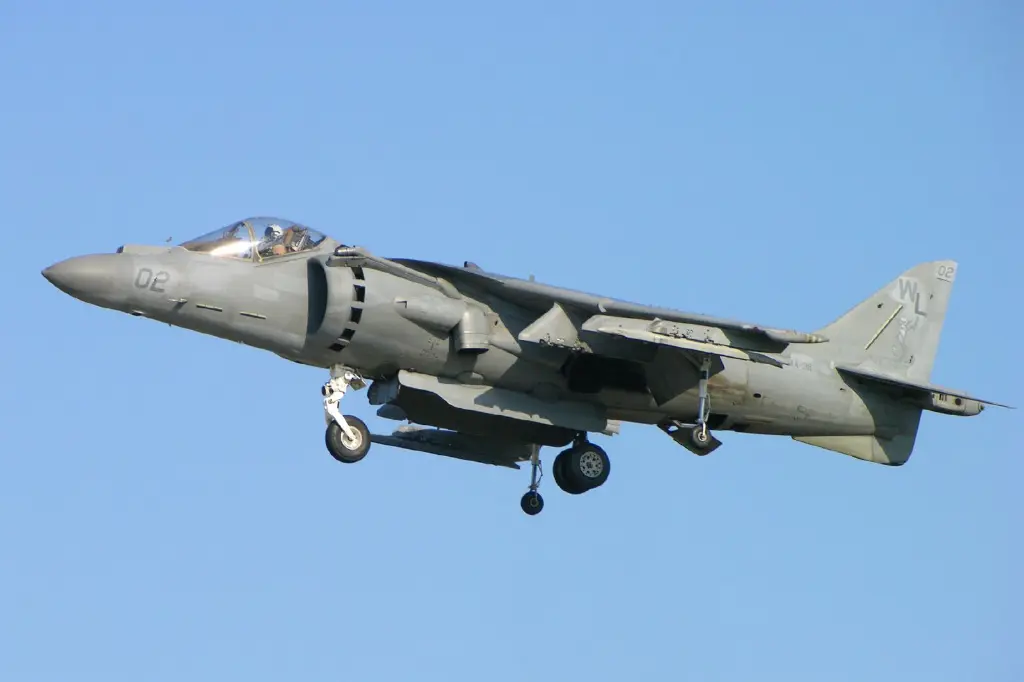AV-8B Harrier II

The AV-8B Harrier II is a second-generation vertical/short takeoff and landing (V/STOL) multirole fighter aircraft developed by McDonnell Douglas (now Boeing) and British Aerospace. First introduced in 1985, the Harrier II is widely used by the U.S. Marine Corps and other operators for close air support, reconnaissance, and air interdiction missions. Its unique ability to operate from short or improvised runways makes it a versatile platform for expeditionary operations.
Fact Sheet
| Role | V/STOL multirole fighter |
|---|---|
| Manufacturer | McDonnell Douglas / British Aerospace |
| First Flight | 1981 |
| Service Entry | 1985 |
| Crew | 1 |
Specifications
| Length | 14.12 m (46 ft 4 in) |
|---|---|
| Wingspan | 9.25 m (30 ft 4 in) |
| Height | 3.55 m (11 ft 8 in) |
| Empty Weight | 6,340 kg (13,975 lb) |
| Max Takeoff Weight | 14,061 kg (31,000 lb) |
| Powerplant | 1 × Rolls-Royce Pegasus 11-61 turbofan |
| Thrust | 23,500 lbf (105 kN) |
| Max Speed | Mach 0.9 (1,065 km/h; 662 mph) |
| Service Ceiling | 15,240 m (50,000 ft) |
| Range | 1,000 mi (1,609 km) combat radius |
| Rate of Climb | ~14,700 ft/min (75 m/s) |
Avionics & Armament
| Main Radar | AN/APG-65 radar |
|---|---|
| Avionics | Navigation/attack systems, targeting pods |
| Armament | One 25-mm GAU-12/U rotary cannon (300 rounds); Up to 6 external hardpoints for: – Air-to-air missiles (AIM-9 Sidewinder) – Air-to-ground munitions (JDAMs, rockets, bombs) – External fuel tanks |
Notable Features
- V/STOL capability for operations from short or improvised runways.
- Multirole design for close air support, reconnaissance, and interdiction.
- Proven combat record in multiple conflicts.
- Compact size for easy deployment on amphibious assault ships.
- Widely used by the U.S. Marine Corps and allied nations.

The Jump Jet Legend: Understanding the AV-8B Harrier II
Imagine a powerful jet aircraft that doesn’t need a long runway to take off or land. It can simply rise straight up from a ship’s deck, a forest clearing, or even a highway. That’s the incredible capability of the AV-8B Harrier II, often called the “Jump Jet.” This unique aircraft has served the United States Marine Corps (USMC), the Spanish Navy, and the Italian Navy for decades, providing unmatched flexibility and rapid response in close air support and attack missions.
Let’s dive into what makes the AV-8B Harrier II a truly special and enduring military aircraft.
A Legacy of Innovation: The Harrier’s British Roots
The story of the Harrier begins in the United Kingdom in the 1960s with the Hawker Siddeley Harrier. This groundbreaking aircraft was the world’s first successful Vertical/Short Takeoff and Landing (V/STOL) jet. The idea was to create an aircraft that could operate from improvised bases, making it less vulnerable than those relying on large, fixed airfields.
The AV-8B Harrier II is the second generation of this revolutionary design, developed jointly by McDonnell Douglas (now part of Boeing) in the U.S. and British Aerospace in the UK. The AV-8B first flew in November 1981 and entered service with the USMC in January 1985. It was a significant upgrade from the original Harrier, with a larger composite wing, more powerful engine, and improved systems, designed to double the original Harrier’s payload and range.
The Magic of Vectored Thrust: How it Works
The Harrier’s defining feature is its ability to take off and land vertically, or with a very short run. This is achieved through a brilliant piece of engineering:
- Rotatable Nozzles: The heart of the Harrier’s V/STOL capability is its single, powerful Rolls-Royce Pegasus turbofan engine. This engine has four nozzles (two on each side of the fuselage) that can be rotated.
- Directing the Thrust: For vertical takeoff, the pilot rotates these nozzles downwards, directing the immense thrust directly towards the ground. This pushes the aircraft straight up into the air.
- Transition to Forward Flight: Once airborne, the pilot gradually rotates the nozzles backward, directing the thrust to propel the aircraft forward. The wings then generate lift like a conventional aircraft.
- Vertical Landing (Hover): For a vertical landing, the process is reversed. The pilot slows the aircraft, rotates the nozzles downwards again, and uses precise control inputs to hover and descend gently to the ground.
- Short Takeoff (STO): The Harrier can also perform a short takeoff, especially when heavily loaded. By starting with the nozzles rotated slightly backward, it gains some forward speed before rotating them fully downwards for extra lift. This allows it to carry more fuel and weapons than a pure vertical takeoff. This is commonly done from “ski-jump” ramps on amphibious assault ships.
This unique system gives the Harrier incredible operational flexibility, allowing it to deploy rapidly to remote locations or operate from ships without traditional long flight decks.
Built for the Fight: Capabilities and Armament
While famous for its unique flight capabilities, the AV-8B Harrier II is also a capable attack aircraft and a formidable asset in combat:
- Close Air Support (CAS): This is the Harrier’s primary mission. Its ability to operate from nearby, austere locations means it can get to the battlefield quickly and provide responsive air support to ground troops.
- Deep Air Support: It can conduct armed reconnaissance and air interdiction missions, striking targets behind enemy lines.
- Multi-Role Versatility: Later upgrades, particularly the AV-8B Harrier II Plus, added new capabilities. These radar-equipped variants can perform offensive and defensive anti-air warfare, including combat air patrols and escort missions.
- Weapons Payload: The Harrier II can carry a substantial amount of ordnance on its seven hardpoints (six under the wings and one under the fuselage). This includes:
- Air-to-Air Missiles: AIM-9 Sidewinder (infrared-guided) and, for radar-equipped versions, the AIM-120 AMRAAM (radar-guided, for beyond-visual-range engagements).
- Air-to-Surface Missiles: AGM-65 Maverick (for anti-armor) and AGM-88 HARM (for attacking enemy radar).
- Bombs: Various types of unguided bombs (like Mk 80 series), laser-guided bombs (like GBU-12/16 Paveway), and GPS-guided bombs (like GBU-38/54 JDAMs).
- Cannon: An internal 25mm GAU-12 Equalizer rotary cannon for close-range strafing runs.
- Advanced Avionics: The AV-8B Night Attack and Harrier II Plus versions feature a more advanced cockpit compatible with Night Vision Goggles (NVG), a Forward-Looking Infrared (FLIR) sensor, and an AN/AAQ-28V LITENING targeting pod. The Harrier II Plus also gained the AN/APG-65 radar, similar to that on the F/A-18 Hornet, greatly enhancing its all-weather and night combat capabilities.
A Proven Combat Record
The AV-8B Harrier II has seen extensive combat across various conflicts, proving its versatility and responsiveness:
- Operation Desert Storm (1991): Harriers were among the first Marine Corps tactical strike aircraft to arrive in the theater. They flew over 3,380 sorties, operating from both land-based expeditionary airfields and sea platforms, providing critical close air support to ground forces.
- Operations in the Balkans (Bosnia, Kosovo): Harriers were deployed for strike and interdiction missions, demonstrating their ability to operate effectively in complex environments.
- Operations in Afghanistan and Iraq: They played a crucial role in supporting ground troops, often operating from austere forward bases or amphibious assault ships, highlighting their unique expeditionary capabilities.
- Recent Engagements: Harriers have continued to be active, notably participating in operations against Houthi drones in the Red Sea, showcasing their enduring relevance even against modern threats.
Phasing Out: The F-35B Takes the Baton
While the AV-8B Harrier II has been an incredibly successful and vital aircraft, it is now reaching the end of its long service life, particularly with the U.S. Marine Corps. The Harrier is being progressively retired and replaced by the F-35B Lightning II. The F-35B, also a V/STOL aircraft, brings enhanced stealth, sensor fusion, and networked capabilities, representing the next generation of close air support for the Marines.
However, the legacy of the AV-8B Harrier II will live on. It revolutionized naval aviation and demonstrated the immense value of Vertical/Short Takeoff and Landing capabilities in military operations. Its unique ability to launch and land almost anywhere made it a true game-changer, and it remains a testament to innovative aircraft design.



